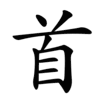首
| ||||||||
| ||||||||
Translingual
| Stroke order | |||
|---|---|---|---|
| Stroke order | |||
|---|---|---|---|
 | |||
Han character
首 (Kangxi radical 185, 首+0, 9 strokes, cangjie input 廿竹月山 (THBU), four-corner 80601, composition ⿱丷𦣻 or ⿱䒑自)
- Kangxi radical #185, ⾸.
Derived characters
Further reading
- KangXi: page 1427, character 32
- Dai Kanwa Jiten: character 44489
- Dae Jaweon: page 1953, character 27
- Hanyu Da Zidian (first edition): volume 7, page 4500, character 1
- Unihan data for U+9996
Chinese
| simp. and trad. |
首 | |
|---|---|---|
| alternative forms | 𩠐 𦣻 | |
Glyph origin
| Historical forms of the character 首 | |||
|---|---|---|---|
| Shang | Western Zhou | Shuowen Jiezi (compiled in Han) | Liushutong (compiled in Ming) |
| Oracle bone script | Bronze inscriptions | Small seal script | Transcribed ancient scripts |
 |
 |
 |
 |
Simplified from 𩠐 (shǒu) (巛 → 丷). Originally pictographic (象形) of an animal with a long mouth and horns. In the oracle bone script, it appeared with or without hair (巛), but 𩠐, the form with hair, was the form that was perpetuated.
Etymology
From Proto-Sino-Tibetan *k-lu; cognate with Mizo lu (“head”) and possibly Burmese ရှု (hru., “to turn one's head toward, to view; to aim”). This word has also been compared with Proto-Austronesian *quluh (“head”) (Malay hulu) and Proto-Tai *klawꟲ ~ krawꟲ (“head; hair knot”) (Thai เกล้า (glâao, “hair; head”)), and was used by Sagart to support his Sino-Austronesian hypothesis. Compare 道 (OC *l'uːʔ, “path, road”) (with the same phonetic component) and its relationship with Proto-Hmong-Mien *kləuX (“road, way”).
This word was replaced by 頭 (OC *doː, “head”) by the Warring States period, possibly due to early homophony with 手 (OC *hnjɯwʔ, “hand”).
Pronunciation 1
Definitions
首
- (archaic, anatomy) head
- 愛而不見,搔首踟躕。 [Pre-Classical Chinese, trad.]
- From: The Classic of Poetry, c. 11th – 7th centuries BCE, translated based on James Legge's version
- Ài ér bù jiàn, sāo shǒu chíchú. [Pinyin]
- Loving and not seeing her, I scratch my head, and am in perplexity.
爱而不见,搔首踟蹰。 [Pre-Classical Chinese, simp.]
- chief; leader
- start; beginning
- first; best; highest
- prime; prior; primary
- side; direction
- Classifier for songs and poems. ⇒ all nouns using this classifier
Synonyms
Pronunciation 2
Definitions
首
Compounds
|
|
|
References
- “首”, in 漢語多功能字庫 (Multi-function Chinese Character Database), 香港中文大學 (the Chinese University of Hong Kong), 2014–
Japanese
Readings
Compounds
- 機首 (kishu)
Etymology 1
| Kanji in this term |
|---|
| 首 |
| くび Grade: 2 |
| kun’yomi |
| Alternative spellings |
|---|
| 頸 頚 |
From Old Japanese, from Proto-Japonic *kumpi.
Noun
首 • (kubi)
Derived terms
Etymology 2
| Kanji in this term |
|---|
| 首 |
| おびと Grade: 2 |
| kun’yomi |
From Old Japanese. First cited to the Nihon Shoki of 720 CE.[2]
Shift from Old Japanese 大人 (opobito, “boss, chief”, literally “big person”).[2][3]
/opobito/ → /obito/
Pronunciation
- IPA(key): [o̞bʲito̞]
See also
- Appendix:Gikun_Usage_in_Meiji_Version_of_Japanese_Bible/首
Etymology 3
| Kanji in this term |
|---|
| 首 |
| こうべ Grade: 2 |
| kun’yomi |
From Old Japanese. First cited to the Nihon Shoki of 720 CE.[2]
Analyzed as a shift from earlier kamipe, as a compound of either 上 (kami, “upper”) or 髪 (kami, “hair”) with the suffix 方 (he, “location”).[2][3]
/kamipe/ → /kampe/ → /kaube/ → /kɔːbe/ → /koːbe/
Noun
- Alternative spelling of 頭 (“head”) (part of the body)
- 2021 September 10, Eve (lyrics and music), “遊生夢死 [Live Playing, Die Dreaming]”:
- 遊生夢死
才能ない脳内 唱えよシスターズ
首を垂れることしかないの- Yūsei bōshi
Sainō nai nōnai tonaeyo shisutāzu
Kōbe o tareru koto shika nai no - Live playing, die dreaming
Chant inside my talentless brain, sisters
All I can do is bow down
- Yūsei bōshi
-
Pronunciation
- IPA(key): [ɕɨᵝ]
See also
References
- 2006, 大辞林 (Daijirin), Third Edition (in Japanese), Tōkyō: Sanseidō, →ISBN
- 1988, 国語大辞典(新装版) (Kokugo Dai Jiten, Revised Edition) (in Japanese), Tōkyō: Shogakukan
- 1995, 大辞泉 (Daijisen) (in Japanese), Tōkyō: Shogakukan, →ISBN
Korean
Etymology
From Middle Chinese 首 (MC ɕɨuX). Recorded as Middle Korean 슈〮 (syú) (Yale: syu) in Hunmong Jahoe (訓蒙字會 / 훈몽자회), 1527.